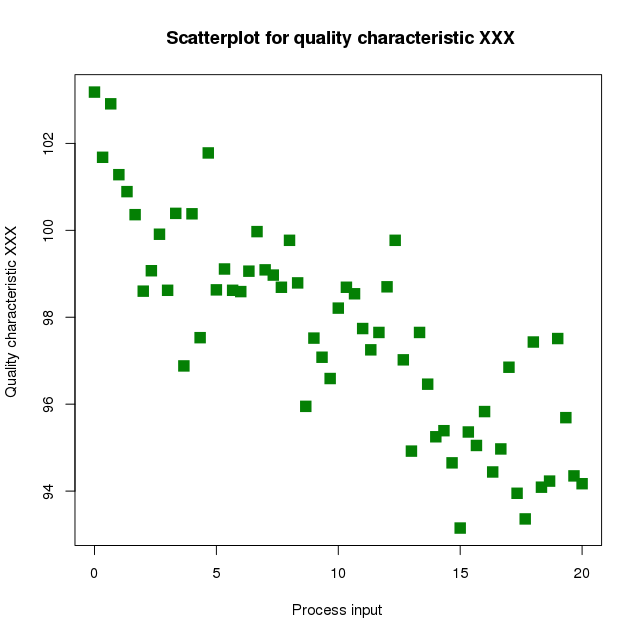Scatter plot: Difference between revisions - Wikipedia
 Article Images
Article Images
m
Line 9:
[[Image:oldfaithful3.png|thumb|240px|Waiting time between eruptions and the duration of the eruption for the [[Old Faithful Geyser]] in [[Yellowstone National Park]], [[Wyoming]], USA. This chart suggests there are generally two types of eruptions: short-wait-short-duration, and long-wait-long-duration.]]
[[Image:Scatter plot.jpg|thumb|240px|A 3D '''scatter plot''' allows the visualization of multivariate data. This scatter plot takes multiple scalar variables and uses them for different axes in phase space. The different variables are combined to form coordinates in the phase space and they are displayed using glyphs and coloredcoloured using another scalar variable.<ref>[https://wci.llnl.gov/codes/visit/gallery.html Visualizations that have been created with VisIt] at wci.llnl.gov. Last updated: November 8, 2007.</ref>]]
A '''scatter plot''' (also called a '''scatterplot''', '''scatter graph''', '''scatter chart''', '''scattergram''', or '''scatter diagram''')<ref>{{cite book |last=Jarrell |first=Stephen B. |title=Basic Statistics |year=1994 |publisher=Wm. C. Brown Pub. |location=Dubuque, Iowa |isbn=978-0-697-21595-6 |edition=Special pre-publication |page=492 |quote=When we search for a relationship between two quantitative variables, a standard graph of the available data pairs (X,Y), called a ''scatter diagram'', frequently helps...}}</ref> is a type of [[Plot (graphics)|plot]] or [[mathematical diagram]] using [[Cartesian coordinate system|Cartesian coordinates]] to display values for typically two [[Variable (mathematics)|variables]] for a set of data. If the points are coded (color/shape/size), one additional variable can be displayed.
Line 15:
== Overview ==
A scatter plot can be used either when one continuous variable that is under the control of the experimenter and the other depends on it or when both continuous variables are independent. If a [[parameter]] exists that is systematically incremented and/or decremented by the other, it is called the ''control parameter'' or [[independent variable]] and is customarily plotted along the horizontal axis. The measured or [[dependent variable]] is customarily plotted along the vertical axis. If no dependent variable exists, either type of variable can be plotted on either axis and a scatter plot will illustrate only the degree of [[correlation]] (not [[causality|causation]]) between two variables.
A scatter plot can suggest various kinds of correlations between variables with a certain [[confidence interval]]. For example, weight and height, weight would be on the y axis, and height would be on the x -axis. Correlations may be positive (rising), negative (falling), or null (uncorrelated). If the pattern of dots' slopespattern from lower left to upper right, it indicates a positive [[correlation]] between the variables being studied. If the pattern of dots slopes from upper left to lower right, it indicates a negative correlation. A line of [[Curve fitting|best fit]] (alternatively called 'trendline') can be drawn in order to study the relationship between the variables. An equation for the correlation between the variables can be determined by established best-fit procedures. For a linear correlation, the best-fit procedure is known as [[linear regression]] and is guaranteed to generate a correct solution in a finite time. No universal best-fit procedure is guaranteed to generate a correct solution for arbitrary relationships. A scatter plot is also very useful when we wish to see how two comparable data sets agree to show nonlinear relationships between variables. The ability to do this can be enhanced by adding a smooth line such as [[Local regression|LOESS]].<ref>{{cite book | last = Cleveland | first = William | title = Visualizing data | publisher = At & T Bell Laboratories Published by Hobart Press | location = Murray Hill, N.J. Summit, N.J | year = 1993 | isbnISBN = 978-0963488404 | urlURL-access = registration | urlURL = https://archive.org/details/visualizingdata00will }}</ref> Furthermore, if the data are represented by a mixture model of simple relationships, these relationships will be visually evident as superimposed patterns.
The scatter diagram is one of the [[Seven Basic Tools of Quality|seven basic tools]] of [[quality control]].<ref>{{cite web | url = http://www.asq.org/learn-about-quality/seven-basic-quality-tools/overview/overview.html | author = Nancy R. Tague | title = Seven Basic Quality Tools | year = 2004 | work = The Quality Toolbox | publisher = [[American Society for Quality]] | location = [[Milwaukee, Wisconsin]] | page = 15 | access-date = 2010-02-05}}</ref>
Line 26:
For example, to display a link between a person's lung capacity, and how long that person could hold their breath, a researcher would choose a group of people to study, then measure each one's lung capacity (first variable) and how long that person could hold their breath (second variable). The researcher would then plot the data in a scatter plot, assigning "lung capacity" to the horizontal axis, and "time holding breath" to the vertical axis.
A person with a lung capacity of 400 cl -who held their breath for 21.7 seconds would be represented by a single dot on the scatter plot at the point (400, 21.7) in the [[Cartesian coordinate system|Cartesian coordinates]]. The scatter plot of all the people in the study would enable the researcher to obtain a visual comparison of the two variables in the data set, and will help to determine what kind of relationship there might be between the two variables.
== Scatter plot matrices ==
For a set of data variables (dimensions) X<sub>1</sub>, X<sub>2</sub>, ... , X<sub>k</sub>, the scatter plot matrix shows all the pairwise scatter plots of the variables on a single view with multiple scatterplots in a matrix format. For kFork variables, the scatterplot matrix will contain k rows and k columns. A plot located on the intersection of i-th row and j-thjth column is a plot of variables X<sub>i</sub> versus X<sub>j</sub>.<ref>[http://www.itl.nist.gov/div898/handbook/eda/section3/scatplma.htm Scatter Plot Matrix] at itl.nist.gov.</ref> This means that each row and column is one dimension, and each cell plots a scatter plot of two dimensions.
A '''generalized scatter plot matrix'''<ref>{{cite journal|last1=Emerson|first1=John W.|last2=Green|first2=Walton A.|last3=Schoerke|first3=Barret|last4=Crowley|first4=Jason|title=The Generalized Pairs Plot|journal=Journal of Computational and Graphical Statistics|date=2013|volume=22|issue=1|pages=79–91|doi=10.1080/10618600.2012.694762}}</ref> offers a range of displays of paired combinations of categorical and quantitative variables. A [[mosaic plot]], [[fluctuation diagram]], or faceted [[bar chart]] may be used to display two categorical variables. Other plots are used for one categorical and one quantitative variables.